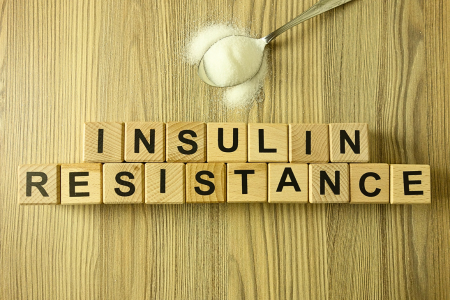As someone with PCOS, it’s vital to understand how insulin resistance may play a role in your condition. The more you understand about this, the better you can work with your medical providers and the more control you can have over your health.
Polycystic Ovary Syndrome (PCOS) is a complex hormonal disorder that presents in different ways among different women. The common thread is an imbalance in reproductive hormones, which can lead to irregular menstrual periods and other symptoms such as excess hair growth and acne.
While insulin resistance is a common feature in PCOS, it’s not present in all cases. In fact, about 20-30% of women with PCOS do not have insulin resistance. This variation might be due to differences in the specific hormonal and metabolic disturbances, genetic factors, and lifestyle factors such as diet and physical activity level.
It’s also possible for a woman to have PCOS without being overweight or obese, a condition often referred to as “Lean PCOS”. Even though obesity and insulin resistance often go hand in hand, lean women with PCOS might still have an imbalance in their reproductive hormones leading to the typical PCOS symptoms, but not exhibit insulin resistance.
What is Insulin Resistance?
Insulin is a hormone produced by your pancreas. Its main job is to regulate blood sugar levels by helping your cells absorb glucose. Insulin resistance happens when your body’s cells don’t respond well to insulin, leading to high levels of both insulin and glucose in your blood. It’s a key factor in the development of type 2 diabetes and it is often associated with PCOS.
Understanding Insulin and Its Function
Insulin is a vital hormone, produced by beta cells in the pancreas. After you consume food, carbohydrates are broken down into glucose, a simple sugar that is the body’s primary source of energy. The increase in glucose triggers your pancreas to produce and release insulin. This hormone acts as a key, unlocking your body’s cells so that glucose can enter them and provide energy. It’s a crucial part of maintaining a healthy energy balance in your body.
Insulin Resistance: An Impaired Response
Insulin resistance, on the other hand, disrupts this process. It is a condition where your body’s cells become less responsive to the effects of insulin. Think of it as the cell’s lock being rusty – the key (insulin) doesn’t work as well as it should, and less glucose can enter the cells.
This causes two major problems. Firstly, because glucose can’t enter the cells effectively, it builds up in the blood, leading to high blood sugar levels. Secondly, in response to this high blood sugar, the pancreas produces more insulin in an attempt to encourage cells to take in more glucose. This leads to an excess of insulin in the blood.
Over time, the pancreas may struggle to keep up with this increased demand for insulin production. This can lead to the development of type 2 diabetes, a condition where the body doesn’t produce enough insulin or the body’s cells ignore insulin.
Insulin Resistance and PCOS: The Connection
Insulin resistance is often linked to Polycystic Ovary Syndrome (PCOS), a hormonal disorder common among women of reproductive age. Women with PCOS often produce more insulin than women without the disorder due to the presence of insulin resistance. This excess insulin stimulates the ovaries to produce more androgens (like testosterone), which can interfere with ovulation, cause acne and hirsutism (excessive hair growth), and lead to weight gain – common symptoms of PCOS.
Insulin resistance doesn’t just impact glucose and insulin levels; it also plays a significant role in lipid metabolism, contributing to an abnormal lipid profile seen in many women with PCOS. This includes higher levels of triglycerides and lower levels of high-density lipoprotein (HDL), the “good” cholesterol.
Understanding the interplay between insulin resistance and PCOS is crucial for managing the syndrome effectively. Addressing insulin resistance through lifestyle modifications and, if necessary, medication, can help manage the symptoms of PCOS, reduce the risk of complications, and improve overall health.
Symptoms of Insulin Resistance in PCOS
If you have insulin resistance, you might experience a few distinct symptoms. This includes weight gain (especially around the waist), dark patches of skin (acanthosis nigricans), and feeling tired after meals. It’s worth noting that these symptoms often overlap with those of PCOS, such as irregular periods, acne, and difficulty losing weight.
Lab Tests for Detecting Insulin Resistance
If you suspect you have insulin resistance, there are several lab tests your healthcare provider might recommend. These could include a fasting insulin level, HOMA-IR, or a glucose tolerance test. Each of these tests provides different information about your body’s insulin sensitivity, so they’re often used together to provide a comprehensive picture.
Laboratory tests used to detect insulin resistance:
- Fasting Insulin Level: As the name suggests, this test requires the patient to fast (usually overnight) before a blood sample is drawn. This sample is then used to measure the level of insulin in the blood. Elevated fasting insulin levels can be an early indicator of insulin resistance, as the body may need to produce more insulin to effectively lower blood glucose levels.
- Homeostatic Model Assessment for Insulin Resistance (HOMA-IR): This test estimates insulin resistance by using a mathematical model that incorporates both fasting glucose and insulin levels. Specifically, it calculates the ratio of fasting insulin to fasting glucose, as this ratio can provide insight into how hard the body has to work to maintain proper blood glucose levels. A higher HOMA-IR score usually indicates greater insulin resistance.
- Glucose Tolerance Test (GTT): This test evaluates how quickly the body can clear glucose from the bloodstream. After fasting, the patient consumes a solution with a high concentration of glucose, and blood samples are taken at regular intervals for several hours to measure the glucose and sometimes insulin levels. If the glucose levels remain high for a prolonged period, it suggests the body is not effectively using insulin to lower blood glucose levels, which is a sign of insulin resistance.
- Hemoglobin A1c (HbA1c): Although this test isn’t directly used to detect insulin resistance, it is an important marker for long-term glucose control and is often used in diagnosing and monitoring diabetes. HbA1c measures the percentage of hemoglobin – a protein in red blood cells – that is coated with sugar, reflecting average blood glucose levels over the past two to three months. Higher levels of HbA1c can suggest problems with insulin sensitivity.
- Lipid Profile: People with insulin resistance often have alterations in their lipid profile, like increased triglyceride levels and decreased HDL cholesterol (“good cholesterol”). Thus, a comprehensive lipid profile can also be helpful in assessing insulin resistance.
- C-Peptide Test: C-peptide is produced in the body along with insulin. This test measures the level of c-peptide in the blood, which indirectly indicates the amount of insulin produced by the body. Higher c-peptide levels may suggest more insulin is being produced due to insulin resistance.
These tests aren’t always definitive, and a single test alone may not sufficient to diagnose insulin resistance. They are all pieces of a larger puzzle, and healthcare providers often use them together, along with physical examination and consideration of individual risk factors and symptoms, to provide a comprehensive assessment of a patient’s insulin sensitivity.
Understanding Body Types and Insulin Resistance
Lean PCOS refers to women who are diagnosed with Polycystic Ovary Syndrome but who are not overweight or obese. Contrary to popular belief, not all women with PCOS are overweight or obese. Lean PCOS can be difficult to diagnose as it does not present the typical PCOS picture that includes weight gain, particularly around the abdomen. Nonetheless, women with lean PCOS still experience hormonal imbalances and other symptoms characteristic of PCOS, such as irregular periods, elevated levels of androgens, and polycystic ovaries identified on ultrasound.
Even though they maintain a normal weight, some women with Lean PCOS can still have insulin resistance. Studies have found that insulin resistance in PCOS isn’t strictly associated with excess weight, meaning that even lean women with PCOS can be affected. Insulin resistance in these cases might arise due to factors like genetic predisposition, inflammation, or increased production of insulin by the pancreas.
On the flip side, overweight or obese women with PCOS are more likely to have insulin resistance. Extra weight, particularly if it’s carried in the abdominal area, decreases the body’s sensitivity to insulin, leading to insulin resistance. This occurs because visceral fat, the fat that surrounds the organs in the belly, releases various substances that negatively impact insulin signaling.
Regardless of body type, insulin resistance in women with PCOS can lead to a host of health complications. These include an elevated risk of developing type 2 diabetes, metabolic syndrome, cardiovascular diseases, and fertility issues.
Lifestyle modifications are crucial for managing both PCOS and insulin resistance. This includes regular exercise and a balanced, nutrient-rich diet. For some women, weight loss, if they are overweight, can significantly enhance insulin sensitivity and alleviate PCOS symptoms. Yet, even in cases of Lean PCOS, lifestyle changes can contribute to better insulin sensitivity and symptom management.
Lifestyle Implications and Modifications
Understanding your insulin resistance status is crucial as it directly impacts the lifestyle choices you’ll need to make. Research suggests that specific dietary modifications can help manage insulin resistance. One example is adopting a low-carb diet, which focuses on reducing intake of carbohydrates, particularly simple sugars and refined carbs. These can cause abrupt spikes and crashes in blood sugar levels. Instead, a low-carb diet promotes the consumption of proteins, healthy fats, and complex carbohydrates that are high in fiber. This can help control blood sugar levels more effectively and lessen the amount of insulin your body needs to produce.
However, it’s important to mention that low-fat diets may not be a beneficial choice for those with insulin resistance. While it may seem intuitive to lower fat intake for weight loss or heart health, a diet too low in fats can lead to increased consumption of carbohydrates, particularly if those carbs are from processed or refined sources. This, in turn, can exacerbate insulin resistance by causing a significant rise and fall in blood sugar levels.
Another valuable dietary approach is the Mediterranean-style diet. This diet, rich in fruits, vegetables, whole grains, lean proteins, and healthy fats, like olive oil and fish, supports maintaining stable blood sugar levels, reducing inflammation, and providing a balanced nutrient intake to support overall health.
Exercise is another essential element in managing insulin resistance. Regular physical activity, such as cardiovascular exercise and strength training, can lower blood sugar levels and decrease the body’s insulin needs. Cardiovascular exercises, like brisk walking, running, cycling, or swimming, improve heart health and aid in regulating insulin levels. Strength training, like weight lifting or resistance exercises, helps build lean muscle mass, which in turn allows your body to store more glucose.
Stress management is also a critical factor in controlling insulin resistance. Techniques such as mindfulness, yoga, and simple breathing exercises can reduce stress levels and improve mental health, which indirectly benefit insulin sensitivity. For example, mindfulness involves focusing on the present moment without judgment, while yoga combines physical postures, breathing exercises, and meditation. Simple practices like deep breathing or guided breathwork also contribute to reducing stress and promoting relaxation.
Remember, adopting these lifestyle modifications is a personal journey and not a one-size-fits-all approach. It’s essential to consult with healthcare providers or a dietitian to create a personalized plan that fits your lifestyle, preferences, and medical needs.
Conclusion
So, it’s clear that insulin resistance is a crucial piece of the PCOS puzzle. It can dictate the symptoms you experience, the treatment strategies that will work best for you, and the lifestyle changes you’ll want to consider. Keep in mind that every woman with PCOS is unique. Understanding your body and how it relates to insulin resistance can be empowering and vital for your health journey. As always, consult with your healthcare provider for personalized advice. Stay strong, stay informed, and take care.

 Scan Me!
Scan Me!


